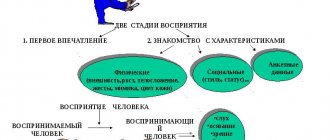One of the most important sources of knowledge of the world around us is its study with the help of the senses. The scientific name for this phenomenon is perception. It is known that the foundations of perception, that is, sensory perception, are laid in a person even while he is in the mother’s womb. With age, perception begins to play an increasingly important role in the worldview and the formation of a picture of the world.
Sensory perception of the world helps people correctly assess the situation
Perceptual actions: what are they?
Perception, or perception, is a person’s ability to reflect surrounding objects and situations. Based on the data obtained in the process of perception, knowledge of the surrounding reality is carried out and an individual (subjective) understanding of it is formed.
Each person is unique, which is why human culture and art are so diverse. However, despite differences in perception, each person goes through certain stages in his development, which are accompanied by the implementation of specific actions. These actions were studied and called perceptual.
Perceptual actions are included in the structure of the perception process and the structure of human activity. Perception is an active process, so it is inextricably linked with activity. From a very early age, a person performs actions aimed at cognition and learning. After all, in order to live in this world, he needs to know this world and be able to interact with it.
The nature of the perception process
The external environment and its individual objects and phenomena influence the senses through analyzers. Their complex interaction ensures the flow of information into the brain centers and its processing.
Complex analysis and synthesis of external data ensure the creation of a holistic image: external and hidden, internal properties and qualities of the object are determined. That is, a number of its characteristics are formed.
The process of perceiving the same object is unique, as is its mental image, since they depend on the individual mental and physiological characteristics of a person. Life principles, views, motives, interests, preferences as the results of upbringing and lifestyle certainly determine the assessment of the properties and qualities of an object. For example, the same work of art can be emotionally assessed by different observers as “strikingly beautiful” and… “disgusting.”
Stages of formation and development
The formation of perceptual actions occurs during the learning process. Their development is divided into three stages.
At the first stage, the formation of perceptual action itself occurs, which begins with the child performing practical actions with unfamiliar objects. As a result, the formation of perceptual tasks occurs - the formation of an adequate image of an object, which subsequently becomes a sensory standard.
At the second stage, a restructuring of sensory processes (occurring in the sense organs) occurs, which become perceptual actions under the influence of practical activities. Actions are carried out with the help of receptor apparatus (tactile and visual), children become familiar with the spatial properties of objects.
At the third stage, the process of reducing and curtailing external actions occurs. They become hidden, occurring at the level of consciousness and subconscious. The external process of perception becomes an act of instantaneous discretion.
By this time, the child has formed a system of sensory standards (socially developed systems of sensory qualities, for example, a system of geometric shapes, etc.). Thanks to them, sensory-perceptual actions change. They turn from a process of image construction into a process of identification.
Meaning of Perception
The sense organs are conductors and intermediaries between man and the outside world. It is they (visual, auditory, olfactory, tactile, gustatory) that provide a holistic perception of the environment, receiving irritant signals on the receptor surfaces. As a result, a person receives a complete understanding of objects and phenomena, their properties and qualities, and builds his “relationships” with them.
You may be interested in: Measuring the insulation resistance of an electric motor
In addition to sensations, the perception of the world is provided by thinking, speech, memory, therefore the perceptual activity of an individual is a complex cumulative process that depends on many individual properties of his psyche.
Levels
Perceptual action can be divided into four levels:
- detection (characterized by the detection of a stimulus);
- discrimination (at this level perception occurs with the subsequent formation of a perceptual image);
- comparison or identification (at this level, the perceived object is identified with the image that is stored in memory; or several objects are compared);
- identification (the corresponding standard is extracted from memory and the object is categorized).
What is the perceptual side of communication?
The perceptual side of communication (from the Latin perceptio - perception) is a special process that manifests itself in the course of interaction between individuals on the basis of natural communication, thanks to which participants in communication can correctly perceive each other’s actions and actions. In simple terms, within the framework of the perceptual side of communication, people “read” each other, which allows them to receive much more information and go beyond a simple verbal exchange.
Perception characterizes the perception of one person by another, when participants in communication have the opportunity to form an idea of themselves and their interlocutor. This became possible thanks to an understanding of goals and motives, which is no less important than the words spoken out loud. Within the framework of a dialogue, a person carries out an objective assessment of the interlocutor, whose internal qualities may not correspond to his own qualities. This format allows people to understand each other and identify opportunities and prospects for communication based on the coincidence of interests, views and worldview.
In psychology, perception is considered as a person’s ability to display at a cognitive level the objects of the surrounding world that he encounters throughout his life. Among the manifestations of perception are understanding and acceptance. This feature allows people to find a common language and build strong communication.
Game and development
Perceptual actions in preschoolers are a fruitful connection between the actions of orientation and exploration with the actions of execution. And the unity of visual and manual actions ensures the accuracy of perceptual analysis.
Children learn about the world around them through play. While playing, they actively process and assimilate new information. Thus, they accept social norms and rules for successful adaptation in society.
In preschool children, the following types of perceptual actions are distinguished:
- identification actions (object identification);
- actions in relation to the standard (comparing the properties of the object with the standard);
- modeling the actions of perception (by mastering productive activities, the child learns to create new objects: modeling, drawing, inventing).
Types of perception
In psychology, perceptual is associated with perception. Perceptual actions are actions aimed at sensory knowledge of the surrounding world. They can have a different character, depending on the type of perception. Experts distinguish three types of sensory knowledge of the surrounding world:
- cognition through vision;
- cognition through hearing;
- formation of a picture of the world using tactile sensations.
Self-control - what is it in psychology, definition
Knowing the leading type of sensory perception of the patient, the psychologist can easily find an individual approach to him. To do this, it is necessary to make maximum use of exactly that perceptual sphere to which a particular person is most sensitive, using exclusively auditory, visual or tactile stimuli and stimuli. This is not difficult to do; in modern practical psychology there are many ways to activate the work of various senses.
Interesting. People who are equally well developed in all types of sensory perception are extremely rare. Most often, one type is in the lead (for example, visual), other types fade into the background. A person who has no developed perception at all is also a very rare phenomenon.
Visual
A person who has a heightened visual perception of the world reacts especially vividly to any visual stimuli and irritants. As a rule, such people are interested in painting, love to look at pictures, have an excellent visual memory and remember people by their faces.
Auditory
A person who has the most developed auditory method of cognition of the world around him often has absolute pitch and easily reproduces any intonation he hears. Such people often connect their lives with music. The main disadvantage is increased sensitivity to loud and disharmonious sounds.
The perception of sounds plays an important role in the formation of a picture of the world
Tactile
There are people who, in order to remember information, must touch an object with their hands, feel it and remember their tactile sensations. In this case, we can talk about a heightened sense of touch. This type of perception develops especially strongly in early childhood, so exercises with children to improve fine motor skills have the most beneficial effect on memory and intelligence.
Perceptual systems
In the process of activity, a person constantly needs to solve some problems that require the perception of the most adequate reflection of the situation. Human perceptual systems are designed to solve these problems. These include:
- visual system;
- auditory;
- musculocutaneous;
- olfactory-gustatory;
- vestibular.
All of them provide the brain with the necessary information, which is used for the normal functioning and development of a person, both physically and mentally.
Perception in psychology
Perception in psychology is a person’s attitude to the world, which is formed under the influence of information received from the outside through the main sense organs. Translated from Latin, this word means “perception.” The opposite concept is apperception. A person needs to perceive the world correctly, because perception:
- helps to develop the right attitude towards people;
- promotes activation of cognitive function of the brain;
- promotes effective communication;
- makes it possible to correctly evaluate yourself and those around you.
This concept is one of the most studied in theoretical and practical psychology. Perception skills are formed from early childhood, so parents should give their child as much information as possible that can be learned through the senses. This could be music and various sounds, beautiful images, toys for the development of tactile skills.
Human sensory-perceptual system
Sensory processes are sensations. A person constantly feels the influence of the external world on his body: he sees, hears, smells and tastes, feels tactile and temperature effects on his body. It also senses processes occurring inside the body: hunger, pain, excitement or weakness, etc.
The sensory-perceptual system is constantly developing and improving in the process of human life. This is necessary for a person’s successful adaptation to the outside world. A person’s abilities and capabilities depend on the quality of the perception system.
This is especially noticeable when compared with people who have disturbances in the development of perception. The life of a person with disabilities (blindness, deafness, muteness, etc.) differs from the life of an absolutely healthy person. Perceptual actions play a significant role here: the more minor the perception defect, the easier it is to correct and possibly correct it. This is done by specialists - defectologists.
Social perception
Social perceptivity is the perception of another person through the prism of specific social attitudes and stereotypes. It is not always adequate. Perceptual actions are a broad concept, which, in particular, includes the assessment of others, focusing on existing norms in society.
Perceptual skills in social terms are skills that allow you to correctly perceive others. They will be useful for teachers, social workers, and psychological service workers. Mastering the essence of these skills is very important. To do this you need:
- be attentive to others;
- try to notice important details;
- perceive the external and internal world of a person as one whole.
All this will help create a correct understanding of other people and the composition of their psyche.
Intensive communication will help you understand another person.
Mechanisms of social perception
The main mechanisms of social perception are:
- thinking using stereotypes:
- reflexive mechanisms;
- empathy (projective ability to transfer the feelings of others);
- identification of a person with any type of personality.
With the help of these mechanisms, the individual sees others in one light or another.
Effects of social perception
Social perception, unlike physical perception, can be characterized by a person’s attitude towards the world around him and other people. The significance of this effect cannot be underestimated, since the simple or complex social adaptation of an individual largely depends on correct perception. Also, this phenomenon directly affects a person’s character and his level of sociability and openness.
The importance of the perception system for humans
Scientists have been studying higher mental functions of humans (thinking, memory, voluntary action) for many years. The relationship between the system of perception and activity and the development of human thinking has been proven. In turn, thinking has a significant impact on a person’s condition, his abilities and capabilities. Perception is one of the highest mental functions of a person.
In order to live, a person needs to constantly reflect the surrounding reality and respond to the perceived information. Perception provides an individual and at the same time adequate reflection of reality. This is especially important for solving perceptual problems. Perceptual actions in the process of perception play an important role; they ensure the full development of the human psyche.
Simply put, to be healthy and happy, a person needs to be involved in some kind of activity. The brain is designed in such a way that it constantly needs to process and assimilate new information, otherwise it begins to become “lazy.” And a “lazy brain” is the first step to the development of dementia.
Properties of perception
You might be interested in: Psychology. Discretion is...
Perception ensures the functioning of various mental processes.
The perception of an object as a specific image, regardless of its location, provides such a property of perception as objectivity.
Simultaneously with the perception of an image (natural or, for example, drawn), its properties are also reproduced in consciousness.
- Such a property as integrity is expressed in the fact that an object is recognized regardless of whether all its parts are present, whether they are distorted, or whether their location in the object is incorrect.
- The meaningfulness of perception during the normal functioning of the human psyche can be traced in the fact that the observed object is correlated with a specific class, category (classified).
- Observed objects (or situations) are perceived as unchanged, even if the conditions of their demonstration change. So, for example, by feeling an object in complete darkness, a person can correctly determine what it is and name its main characteristics. This property of perceptual activity is called constancy.
- This property of perception, such as structure, allows you to perceive the environment reliably, even if sensations are not connected. The expression “glass surface of a lake” paints a specific image of a perfectly smooth, shiny, bluish-greenish surface of a reservoir.
- The individual state of mind necessarily influences perception: stormy weather delights some, but frightens others immensely and creates a state of panic. This property of perception is called apperception.
- Perception depends on the conditions in which it occurs. The perception of the same thunderstorm in a real situation and, for example, when watching a movie, will occur differently, which is where such a property of perception as contextuality manifests itself.
The influence of cultural and historical experience on a person
Modern people are so accustomed to freely receiving any information that they don’t even think about the fact that this is the result of the activities of a huge number of people. Their contribution to the development of modern society is enormous. Everything that a person can and knows is not only his merit, but also the property of society as a whole.
Perception is a system of perceptual actions, mastery of which occurs in the process of special training and practice. A child can master sensory standards only with the help of an adult who guides him and helps him identify the most significant features of objects and situations. This is very important for analyzing reality and systematizing the child’s personal sensory experience.
There are cases where children were deprived of communication with their own kind. These are the so-called “children of Mowgli”, raised by animals. Even after returning them to human society, it was rarely possible to adapt them to human society.
Manifestations in relationships with others
All people have different perceptual abilities. This depends, in part, on genetics and culture. This quality can also be developed, which is especially important for people whose work is related to communication and teaching. For example, the perceptual abilities of a teacher are the skills of observation, to find an individual approach to each student, regardless of his academic performance, character, or nationality. In relationships with others, perceptive individuals demonstrate a high level of empathy - emotional empathy for the interlocutor.
A person with a high level of development of sensory perception easily finds a common language with others
Does an adult have perceptual activity?
Since perceptual actions are actions of learning and cognition, it may seem that they are unique to childhood. However, this is not so: every time an adult learns something new (a hobby, a new profession, foreign languages, etc.), a system of perceptual actions is activated, which helps to quickly master new knowledge and skills.
Man is a unique creature, his possibilities are limitless, and all this is thanks to consciousness and psyche. It is they who distinguish man from all life on the planet. Only a person is capable of voluntarily regulating his activities in accordance with his desires. Human activity is not chaotic and unsystematic, but is part of the structure of consciousness and thinking. Until now, scientists all over the world are studying the human psyche, making new discoveries, but it still remains a mystery.
Gender characteristics of perception
There are more perceptive personalities among women than among men. Therefore, women are more successful in teaching. This feature must be kept in mind when creating a favorable psychological climate in the team. Men, compared to women, have better developed tactile perception of the world and cognition through tactile experience.
Interesting. In Russia there is a saying that a woman loves with her ears, and a man loves with her eyes. This, in a nutshell, means that representatives of the stronger sex perceive verbal information (for example, compliments) best, while gentlemen are typical visual learners.
It is known that internal perception, useful in interpersonal relationships, as well as intuition, can be developed with the help of special training and spiritual practices, as well as a teacher-psychologist. During some psychological exercises, especially at a young or childhood age, for example, in preschoolers, the main senses begin to perceive the world around them more acutely. At such moments of learning, perception becomes the leading source of knowledge.
InterpretationTranslationPerceptual activity
Human psychology from birth to death. — SPb.: PRIME-EUROZNAK. Under the general editorship of A.A. Reana. 2002.
See what “Perceptual activity” is in other dictionaries:
- perception is a holistic reflection of objects, situations and events that arises from the direct impact of physical stimuli on the receptor surfaces (see receptor) of the sense organs. Together with the processes of sensation... Great Psychological Encyclopedia
- perception - PERCEPTION is a form of sensory cognition that subjectively appears to be immediate and relates to objects (physical things, living beings, people) and objective situations (the relationships of objects, movements, events). For... ... Encyclopedia of Epistemology and Philosophy of Science
- Interpersonal cognition: methods - Skills, abilities and methods of interpersonal cognition (IK) have been studied for a long time as cognitive structural formations. So, in the 1940s. J. Bruner proposed the concept of perception, the central place in which is occupied by the concept ... ... Psychology of communication. encyclopedic Dictionary
- Perception - - 1) a subjective image of an object, phenomenon or process that directly affects the analyzer or system of analyzers (the terms “image of perception”, “perceptual image” are also used); 2) the process of forming this image... ... Dictionary-reference book for social work
- Perception is the ability to synthesize visual images from individual sensations (A.N. Leontiev). The process of perception itself presumably proceeds in several stages and with the participation of such processes. The latter are: 1. focusing on the sensory... ... Encyclopedic Dictionary of Psychology and Pedagogy
- Perception - (from Latin perceptio perception), the process of direct active reflection by the cognitive sphere of a person of external and internal objects (objects), situations, events, phenomena, etc. * * * (Latin perceptio - perception) - perception (as opposed to ... ... Encyclopedic Dictionary of Psychology and Pedagogy
- PSYCHOLOGICAL FOUNDATIONS OF THE METHOD - abstraction, automation, automatism, agrammatism, adaptation, sensory adaptation, social adaptation, adaptability, adequacy of perception, adequacy of sensations, acculturation, acmeology, acceleration, act of activity, activation,... ... New dictionary of methodological terms and concepts (theory and language teaching practice)
- PERCEPTION is a continuous sequence of internal figurative representations that arise in the cognitive system of living beings, reproducing sensory recognizable objects, events, states, etc. Initially, human knowledge is of a sensual nature.… … Philosophical Encyclopedia
- communication is a complex, multifaceted process of establishing and developing contacts between people (interpersonal communication) and groups (intergroup communication), generated by the needs of joint activities and including at least three different processes: communication... ... Great Psychological Encyclopedia
- REPRESENTATION - an image of an earlier perceived object or phenomenon (P. memory, recollection), as well as an image created by the productive imagination; form of feelings. reflection in the form of visual knowledge. In contrast to perception, P. rises above the immediate means... Philosophical Encyclopedia
Interpretation: Perceptual actions are structural units of the human perception process.
P. d. provide the conscious selection of one or another aspect of a sensory given situation, as well as the transformation of sensory information, leading to the construction of an image adequate to the objective world and the tasks of activity. Brief psychological dictionary. — Rostov-on-Don: “PHOENIX”. L.A. Karpenko, A.V. Petrovsky, M. G. Yaroshevsky. 1998.
perceptual actions
Etymology. Comes from Lat. pertertio - perception. Category. The main structural units of the perception process, ensuring the construction of an object image. Specificity. They are implemented using various sets of perceptual operations.
Psychological Dictionary. THEM. Kondakov. 2000.
PERCEPTUAL ACTIONS are the basic structural units of the human perception process.
P. d. are associated with the conscious identification of one or another aspect of a sensory given situation, as well as various kinds of transformations of sensory information, leading to the creation of an image adequate to the tasks of the activity and the objective world. The concept of P. d. was first put forward by A. V. Zaporozhets, in whose school they were most fully studied (see Theory of the development of perception through the formation of perceptual actions). Currently, the understanding of perception as a system of physical activity is widespread in Russian psychology. Close to it are the statements of such prominent foreign psychologists as J. Piaget, J. Gibson, R. Held, W. Neisser. Studies of the ontogenetic (see Ontogenesis) development of perception processes show that at first they are included in the external practical actions of the child. As the activity becomes more complex and the demands it places on the objective reflection of the situation, the process itself is distinguished, carried out in terms of a sensory image. The genetic connection of physical activity with practical actions is manifested in their extensive, external motor nature. In the movements of the hand, feeling an object (see Touch), in the movements of the eyes, tracing the visible contour, in the movements of the larynx, reproducing an audible sound, there is a continuous comparison of the image with the original, its verification and correction is carried out. Further development of activity is accompanied by a significant reduction in the motor components of P etc., as a result of which the process of perception externally takes the form of a one-time (simultaneous) act of “discretion.” These changes are determined by the development in the child of a whole system of operational units of perception and sensory standards that mediate perception and transform it from a process of image construction into a more elementary process of recognition. It is important to note that sensory standards correspond to such socially developed systems of sensory qualities as the generally accepted pitch scale of musical sounds, the “grid” of phonemes of the native language, or a system of geometric shapes. Having mastered systems of sensory standards throughout childhood, the child learns to use them as a kind of sensory standards for systematizing the properties of the surrounding reality. Any sensory action can be realized with the help of a significant number of different perceptual operations.
Of great practical importance is the study of the operational and technical side of specific perceptual (observational) types of labor activity of radar station operators, decipherers of traces of elementary particles and aerial photographs. Among them, such functions were identified and studied as signal detection, identification of information features and familiarization with them, identification, recognition (categorization), i.e., assigning a perceived object to a particular class. The process of coordinating various P.D. and their component operations in micro- and macro-intervals of time has been studied relatively little (see Method of microstructural analysis). It also seems relevant to study the semantic relationships that connect P. d. with the activity in the context of which they are carried out. Solving these problems will allow us to get closer to understanding the psychological mechanisms of aesthetic perception and visual thinking. Large psychological dictionary. — M.: Prime-EUROZNAK. Ed. B.G. Meshcheryakova, acad. V.P. Zinchenko. 2003.
Other books on request “perceptual actions” >> —>
Congruence is the correspondence of the client’s experiences with his physiological reaction and the expression of these experiences in the external plane.
Incongruence is a lack of unity in experience, lack of sincerity. The information a person conveys is ambiguous and inaccurate. Causes tension and protection.
Rogers developed client-centered therapy.
The goal of therapy is to eliminate the dissonance between real experience and self-concepts.
Conditions – phenomenological approach. An important concept in therapy is the internal locus of assessment (the personality’s ability to attribute one’s successes or failures to internal factors), which ensures the client’s autonomy. If the internal locus of assessment is formulated, then the leading locus of assessment becomes the motive for personal growth.
The motive of personal growth sets the vector of direction of all the vital forces of the individual. Rogers defines the motive of personal growth as self-realization (self-actualization).
Self-realization is possible with the ability to live in the present, here and now. A person whose self is actualized is able to live here and now. The concept of self denotes an actualized personality striving for self-actualization and integrity.
Rogers believed that therapy based on the phenomenological theory of personality should be instructive. The psychotherapist should not impose his opinion on the patient, but lead him to the right decision, which the patient makes independently. During the therapy process, the patient learns to trust himself more, his intuition, his feelings and impulses. He begins to understand himself better, and then others. As a result, that “illumination” (insight) occurs, which helps to rebuild one’s self-esteem, “restructure the gestalt,” as Rogers said after Wertheimer and Koehler. This increases congruence and enables a person to accept himself and others, improves his communication with them, reduces anxiety and tension.
Rogers's work has had a significant impact on the general understanding of the potential of the human person. He can rightfully be considered one of the founders of the movement for the general humanization of psychology.
In the 80s of the 20th century, the work of C. Rogers “Freedom to Learn” appeared, in which for the first time a person-centered approach to education was psychologically substantiated. K. Rogers, noting the underestimation of the student himself and his activity as one of the shortcomings of the traditional teaching system, proposes to organize teaching itself as activation, facilitation of the learning process.
Three universal conditions (according to C. Rogers) that form a climate that ensures growth and development:
The first element is sincerity or congruence. The more the therapist is himself in relation to the client, the less he is separated from the client by his professional or personal facade, the more likely it is that the client will change and move forward in a constructive way. Authenticity means that the therapist openly experiences the feelings and attitudes that are occurring in the moment. There is a correspondence or congruence between what is experienced at the somatic level, what is presented in consciousness, and what is expressed to the client.
The second most important attitude is acceptance, caring or recognition - an unconditional positive view of the client. When the therapist experiences a positive, nonjudgmental, accepting attitude toward the client regardless of who the client is at the moment, therapeutic progress or change is more likely. The therapist's acceptance involves allowing the client to be in whatever his immediate experience is - confusion, hurt, outrage, fear, anger, courage, love or pride. This is selfless concern. When the therapist acknowledges the client holistically rather than conditionally, progress is more likely.
The third facilitative aspect of relationship is empathic understanding. This means that the therapist accurately perceives the feelings, personal meanings experienced by the client, and communicates this perceived understanding to the client. Ideally, the therapist penetrates so deeply into the inner world of another that he can clarify not only those meanings that he is aware of, but even those that lie just below the level of awareness. This special, active brand of listening is one of the most powerful forces known to bring about change.
InterpretationTranslationperceptual fieldAviation medicine: perceptual field
Universal Russian-English dictionary. Akademik.ru. 2011.
See what a “perceptual field” is in other dictionaries:
- SENSORY FIELD - 1. See perceptual field. 2. See the area of perception... Explanatory Dictionary of Psychology
- BODY - 1) the name of a material extended thing as something objectively physical; 2) inaccurate name of the material carrier of the life of an organism, in particular the human body; 3) the name of a three-dimensional figure in stereometry. Philosophical encyclopedia ... Philosophical encyclopedia
- Perceptual organization - For most psychologists, the topic of perceptual organization serves as a symbol of Gestalt psychology. It was Kurt Koffka who announced to the scientific world that perception is an organized process. Koffka sharply criticized the so-called. “constancy hypothesis” ... ... Psychological Encyclopedia
- BERKELEY - (Berkeley) George (1685 1753) English. philosopher and religious figure, one of the most prominent and consistent representatives of immaterialism in modern times. Since 1734, bishop in Cloyne (Ireland). Main works: “The Experience of a New Theory of Vision” (1709), ... ... Philosophical Encyclopedia
- CONDILLAC - (Condillac) Etienne Bonnodet (1715 1780) the only major French. empiricist philosopher. At the same time, one of the few educators who was engaged in logical research. Brother G.B. de Mably. From 1752 until the end of his life, royal censor. Grandson's teacher... ...Philosophical Encyclopedia
- PHENOMENOLOGY OF PERCEPTION - 'PHENOMENOLOGY OF PERCEPTION' ('Phénoménologie de la perception'. Paris, 1945) is the main work of Merleau Ponty, which explores the problems of the specificity of the existence of existence (see EXISTENCE) and its relationship with the world as 'vital... ... History of Philosophy: Encyclopedia
- PHENOMENOLOGY OF PERCEPTION - (Phenomenologie de la perception. Paris, 1945) the main work of Merleau Ponty, which explores the problems of the specificity of the existence of existence (see Existence) and its relationship with the world as vital communication, as ceaseless and... ... History of Philosophy: Encyclopedia
- Paul VIRILIO (b. 1932) French philosopher, social theorist, urbanist and architectural critic. He studied philosophy at the Sorbonne, was a professional artist in his youth, and was a religious activist in the 1950s. Took part in campaigns... Sociology: Encyclopedia
- Adlerian psychotherapy (adlerian psychotherapy) - The basics of AP were developed by A. Adler at the time when he was part of S. Freud's group. After separating from Freud's circle in 1911, Adler quickly expanded the basics. provisions of his theory and continued to develop it until his death in... ... Psychological Encyclopedia
- Perception (perception) - By perception, or perception, we mean both the subjective experience of receiving sensory information about the world of people, things and events, and those psychological. processes, thanks to Crimea this is accomplished. Classical theory The idea that all of our... ... Psychological Encyclopedia
- GESTALT PSYCHOLOGY - (from German Gestalt structure, image, form, configuration) one of the influential trends in psychology, trans. floor. 20th century Formed under the direct influence of philosophy. phenomenology (E. Husserl), which argued that the perception of the world is... ... Philosophical Encyclopedia
Sources used:
- https://srazu.pro/teoriya/percepciya-v-psixologii.html
- https://psihologiya_cheloveka.academic.ru/268/perceptual_activity
- https://psychology.academic.ru/3799/perceptual_actions
- https://studopedia.ru/10_219653_fenomenalnoe-pertseptivnoe-pole—eto-opit-poluchenniy-individom-v-hode-vsey-zhizni-i-yavlyayushchiysya-unikalnim-dlya-nego-igraet-bolshuyu-rol-v-formirovanii- ya-kontseptsii.html
- https://universal_ru_en.academic.ru/1980153/perceptual_field











